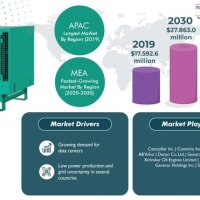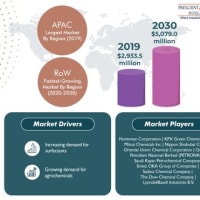The surging number of construction activities in several countries is one of the major factors propelling the demand for polymer concrete across the world.
The biggest trend currently in the polymer concrete market is the increasing awareness amongst the people about the excellent performance of polymer concrete in various construction activities. In many countries, the manufacturers are rapidly shifting toward the use of polymer concrete in construction applications on account of its numerous advantages over the conventionally used forms of concrete such as higher tensile strength and higher impact resistance. Moreover, the traditional forms of concrete have high installation times and poor insulating properties and are therefore, experiencing declining usage all over the world.
Another factor driving the growth of the polymer concrete market is the rising number of repair and maintenance activities. For example, emergency repair of airport runways is quite disruptive for airport operations; however, a rapid patch polymer concrete makes sure that the repair is done in a very short time. Moreover, polymer concrete is utilized in a variety of applications, including marine works, nuclear power plants, roads, and waterproofing of buildings. Furthermore, advantages including high resistance to chemical attack and abrasion, high impact resistance, and low permeability are resulting in rising adoption of polymer concrete.
Epoxy, vinyl ester, and polyester are the different types of polymer concrete, among which, the demand for epoxy was the highest in the past. This is due to the high strength, quick setting, and low shrinkage attributed of epoxy polymer concrete. This type further provides good chemical resistance, which is why, its demand is expected to remain the highest in the coming years as well. Different classes of polymer concrete are polymer impregnated concrete (PIC), polymer modified concrete (PMC), and polymer resin concrete (PRC), out of which, the demand for PMC is predicted to increase significantly in the years to come.
This is because of the properties of PMC, including enhanced freezing resistance, high flexural strength, and superior bond strength. The major application areas of polymer concrete are trench drains, containments & waste containers, flooring blocks, and pump bases. The largest demand for polymer concrete in the past was created for containments & waste container applications, which can be attributed to the easy maintenance and long-lasting durability of containments and extensive applications of waste containers that are made from polymer concrete. Residential structures, civil infrastructure, and non-residential structures are the major end users of polymer concrete.
In terms of application, the polymer concrete market is categorized into pump bases, trench drain, containments & waste containers, flooring blocks, and others (which include outdoor furniture, overlays, solid surface counter, and park benches). Among these, the trench drain category dominated the market during the historical period (2013–2017), holding a share of more than 26.0% in 2017, in terms of value. The reason for this is the growing construction of efficient drainage systems for catering to the needs of the surging population around the world.
Hence, the market is growing due to the increasing number of repair and maintenance activities and rising civil construction projects.
The biggest trend currently in the polymer concrete market is the increasing awareness amongst the people about the excellent performance of polymer concrete in various construction activities. In many countries, the manufacturers are rapidly shifting toward the use of polymer concrete in construction applications on account of its numerous advantages over the conventionally used forms of concrete such as higher tensile strength and higher impact resistance. Moreover, the traditional forms of concrete have high installation times and poor insulating properties and are therefore, experiencing declining usage all over the world.
Another factor driving the growth of the polymer concrete market is the rising number of repair and maintenance activities. For example, emergency repair of airport runways is quite disruptive for airport operations; however, a rapid patch polymer concrete makes sure that the repair is done in a very short time. Moreover, polymer concrete is utilized in a variety of applications, including marine works, nuclear power plants, roads, and waterproofing of buildings. Furthermore, advantages including high resistance to chemical attack and abrasion, high impact resistance, and low permeability are resulting in rising adoption of polymer concrete.
Epoxy, vinyl ester, and polyester are the different types of polymer concrete, among which, the demand for epoxy was the highest in the past. This is due to the high strength, quick setting, and low shrinkage attributed of epoxy polymer concrete. This type further provides good chemical resistance, which is why, its demand is expected to remain the highest in the coming years as well. Different classes of polymer concrete are polymer impregnated concrete (PIC), polymer modified concrete (PMC), and polymer resin concrete (PRC), out of which, the demand for PMC is predicted to increase significantly in the years to come.
This is because of the properties of PMC, including enhanced freezing resistance, high flexural strength, and superior bond strength. The major application areas of polymer concrete are trench drains, containments & waste containers, flooring blocks, and pump bases. The largest demand for polymer concrete in the past was created for containments & waste container applications, which can be attributed to the easy maintenance and long-lasting durability of containments and extensive applications of waste containers that are made from polymer concrete. Residential structures, civil infrastructure, and non-residential structures are the major end users of polymer concrete.
In terms of application, the polymer concrete market is categorized into pump bases, trench drain, containments & waste containers, flooring blocks, and others (which include outdoor furniture, overlays, solid surface counter, and park benches). Among these, the trench drain category dominated the market during the historical period (2013–2017), holding a share of more than 26.0% in 2017, in terms of value. The reason for this is the growing construction of efficient drainage systems for catering to the needs of the surging population around the world.
Hence, the market is growing due to the increasing number of repair and maintenance activities and rising civil construction projects.




















※コメント投稿者のブログIDはブログ作成者のみに通知されます